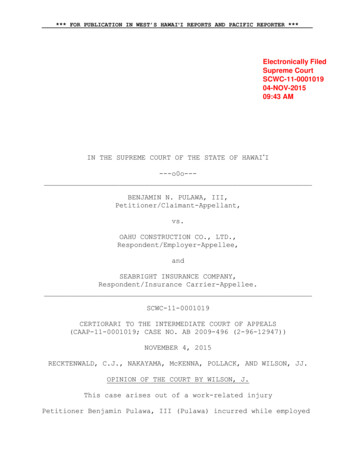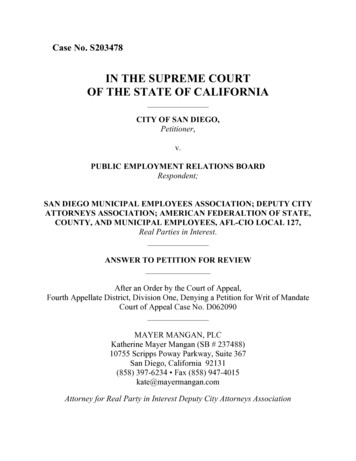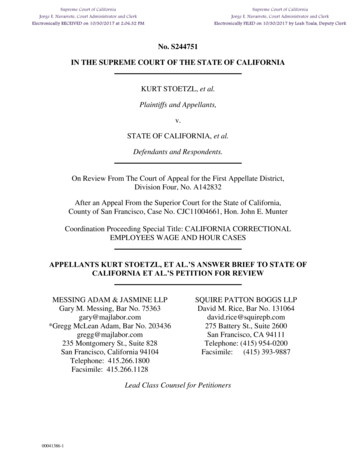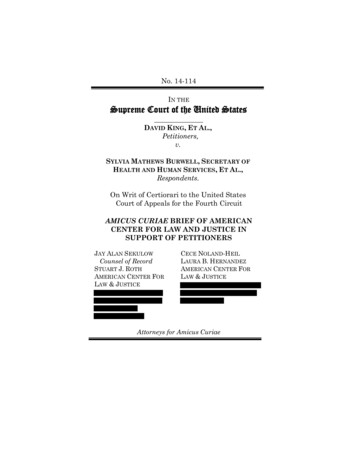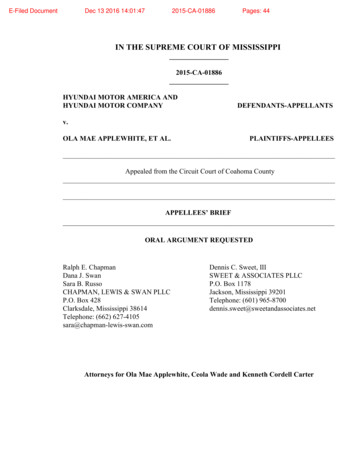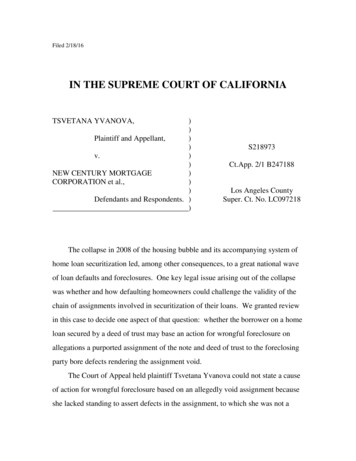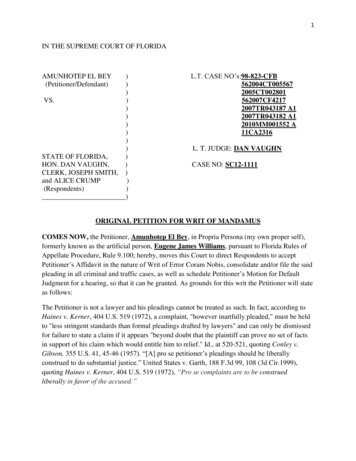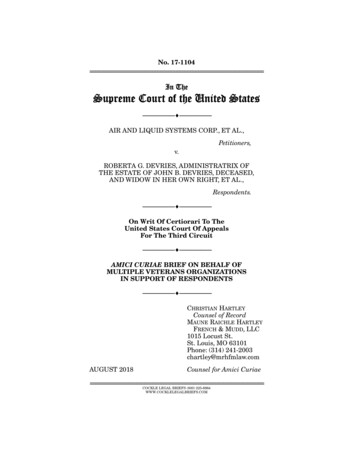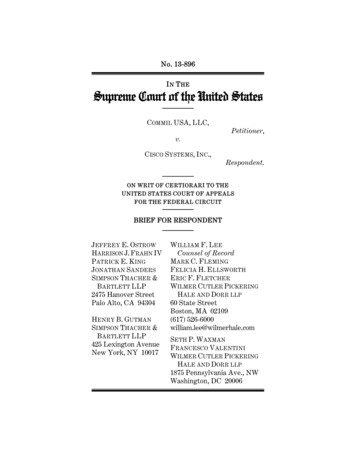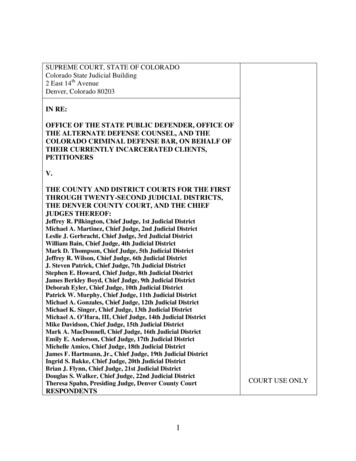
Transcription
SUPREME COURT, STATE OF COLORADOColorado State Judicial Building2 East 14th AvenueDenver, Colorado 80203IN RE:OFFICE OF THE STATE PUBLIC DEFENDER, OFFICE OFTHE ALTERNATE DEFENSE COUNSEL, AND THECOLORADO CRIMINAL DEFENSE BAR, ON BEHALF OFTHEIR CURRENTLY INCARCERATED CLIENTS,PETITIONERSV.THE COUNTY AND DISTRICT COURTS FOR THE FIRSTTHROUGH TWENTY-SECOND JUDICIAL DISTRICTS,THE DENVER COUNTY COURT, AND THE CHIEFJUDGES THEREOF:Jeffrey R. Pilkington, Chief Judge, 1st Judicial DistrictMichael A. Martinez, Chief Judge, 2nd Judicial DistrictLeslie J. Gerbracht, Chief Judge, 3rd Judicial DistrictWilliam Bain, Chief Judge, 4th Judicial DistrictMark D. Thompson, Chief Judge, 5th Judicial DistrictJeffrey R. Wilson, Chief Judge, 6th Judicial DistrictJ. Steven Patrick, Chief Judge, 7th Judicial DistrictStephen E. Howard, Chief Judge, 8th Judicial DistrictJames Berkley Boyd, Chief Judge, 9th Judicial DistrictDeborah Eyler, Chief Judge, 10th Judicial DistrictPatrick W. Murphy, Chief Judge, 11th Judicial DistrictMichael A. Gonzales, Chief Judge, 12th Judicial DistrictMichael K. Singer, Chief Judge, 13th Judicial DistrictMichael A. O’Hara, III, Chief Judge, 14th Judicial DistrictMike Davidson, Chief Judge, 15th Judicial DistrictMark A. MacDonnell, Chief Judge, 16th Judicial DistrictEmily E. Anderson, Chief Judge, 17th Judicial DistrictMichelle Amico, Chief Judge, 18th Judicial DistrictJames F. Hartmann, Jr., Chief Judge, 19th Judicial DistrictIngrid S. Bakke, Chief Judge, 20th Judicial DistrictBrian J. Flynn, Chief Judge, 21st Judicial DistrictDouglas S. Walker, Chief Judge, 22nd Judicial DistrictTheresa Spahn, Presiding Judge, Denver County CourtRESPONDENTS1COURT USE ONLY
Counsel for Petitioner the Office of the State Public DefenderMegan A. RingColorado State Public DefenderJASON MIDDLETON, #25314Chief Appellate DeputyJUD LOHNES, #33208MEGHAN MORRIS, #43963JEANNE SEGIL, #508981300 Broadway, Suite 300Denver, CO 80203Phone: 303-764-1400Fax: usCivil Rights CorpsOLEVIA BOYKIN*1601 Connecticut Avenue NW, Suite 800Washington, DC 20009Phone: 202-844-4975*Pro hac vice admission pendingCounsel for Petitioners the Office of the Alternate DefenseCounsel and the Colorado Criminal Defense BarHollis A. Whitson, # 32911Eric A. Samler, # 32349SAMLER AND WHITSON, P.C.1600 Stout St., Suite 1400Denver, CO 80202303-670-0575Hollis.whitson@gmail.comCase Number: 20SAIN RE:OFFICE OF THE STATE PUBLIC DEFENDER, OFFICE OF THE ALTERNATEDEFENSE COUNSEL, AND THE COLORADO CRIMINAL DEFENSE BAR,V.THE COUNTY AND DISTRICT COURTS FOR THE FIRST THROUGH TWENTYSECOND JUDICIAL DISTRICTS, THE DENVER COUNTY COURT, AND THECHIEF JUDGES THEREOF2
CERTIFICATE OF COMPLIANCEI hereby certify that this petition complies with the requirements of C.A.R. 32,including all formatting requirements in that rule, as required by C.A.R. 21(c). Iacknowledge that the petition may be stricken if it does not comply with therequirements of C.A.R. 32.3
INTRODUCTIONAs this Court recently recognized, “the United States now lies at theepicenter of a global pandemic of COVID-19, a highly contagious and potentiallylethal respiratory disease caused by a novel coronavirus.” In Re: Interrogatory onHouse Joint Resolution 20-1006, 2020 CO 23, ¶ 2. Authorities have asked peopleto stay at home and practice “social distancing” to limit the spread of this infection.Id. at ¶ 10. Even so, “[t]he pandemic is expected to continue into May and possiblywell beyond.” Id. at ¶ 11.For Coloradans detained in densely-populated jails, this is a particularlyfrightening time. These individuals lack the ability to avoid contact with others. Asa result, COVID-19 is likely to spread within jails, and from jails to the broadercommunity. The best way to mitigate the spread of COVID-19 within and fromjails is to significantly reduce jail populations. But jails can only do so muchwithout court action. Thus, courts should take steps to help depopulate jails.ISSUE PRESENTEDWhether trial courts must take steps to reduce jail populations in response tothe COVID-19 crisis to protect the constitutional rights of incarcerated people andthe health of the general public.4
PETITIONERS AND PROPOSED RESPONDENTSThe petitioners in this original proceeding are the Office of the State PublicDefender, the Office of the Colorado Alternate Defense Counsel, and the ColoradoCriminal Defense Bar.The Office of the State Public Defender represents thousands of peopleaccused and convicted of crimes throughout Colorado. Many of those people arecurrently incarcerated in Colorado, either awaiting proceedings on their cases orserving sentences following convictions. Under section 21-1-101(1), C.R.S., theOffice of the State Public Defender is authorized to “serve [their] clientsindependently of any political considerations or private interests, provide legalservices to indigent persons accused of crime that are commensurate with thoseavailable to nonindigents, and conduct the office in accordance with the Coloradorules of professional conduct and with the American bar association standardsrelating to the administration of criminal justice, the defense function.”The Office of the Alternate Defense Counsel (“OADC”) providesrepresentation for indigent persons in criminal and juvenile delinquency cases inwhich the Public Defender determines that an ethical conflict of interest exists.Like the Public Defender, OADC is mandated to “provide to indigent personsaccused of crimes, legal services that are commensurate with those available to5
non-indigents, and conduct the office in accordance with the Colorado Rules ofProfessional Conduct and with the American Bar Association Standards relating tothe administration of criminal justice, the defense function.” § 21-2-101(1), C.R.S.The Colorado Criminal Defense Bar (CCDB) is a non-profit organizationthat provides training and support to the criminal defense community to promotezealous advocacy for those accused of crimes. With almost 1000 members, CCDBis the largest criminal defense bar association in the State. Its members—attorneys,paralegals, and investigators in both the public and private sectors—are dedicatedto the representation of criminal defendants at trial, on appeal, and post-conviction.CCDB works to ensure that Colorado’s criminal justice system embodies theprinciples of liberty, justice, and equality.The proposed respondents are the county and district courts for eachColorado Judicial District via the Chief Judges of each Colorado Judicial Districtand the Presiding Judge of the Denver County Court, each of whom this Court hasdesignated as the “administrative head of all district and county courts within ajudicial district.” CJD 95-01, p. 1 (as amended, August 24, 2016).6
OTHER INTERESTED PARTIESThe following organizations have requested that counsel inform this Courtthat they support the relief sought in this petition: American Civil Liberties Unionof Colorado, Colorado Criminal Justice Reform Coalition, Disability LawColorado, Lawyers Civil Rights Coalition, the Colorado Lawyers Committee, andthe Interfaith Alliance. These entities have all been exceptionally active in workingto protect the rights and lives of Colorado persons who are incarcerated anddetained during this COVID-19 disaster.ENTITIES FROM WHOM RELIEF IS SOUGHTPetitioners seek relief against all Colorado district and county courts withauthority to issue arrest warrants, set conditions of bail and probation, and imposeor modify jail sentences, along with the chief judges with administrative authorityover those courts. See CJD 95-01 (chief judge is “administrative head” of courtswithin a district). There is no specific underlying proceeding; none is required. SeeC.A.R. 21(d)(2)(B) (petitioner should identify “the underlying proceeding, ifany”).7
RELIEF SOUGHTWhile some Colorado trial courts have taken prompt and reasonable actionto reduce jail populations in response to the COVID-19 pandemic, others have not.A swift, unified, and comprehensive response is needed.1 Petitioners ask this Courtto facilitate the reduction of jail populations by directing trial courts to (1) reducethe number of people taken into custody in the first instance, (2) release pretrialdetainees whenever possible, and (3) shorten jail and work-release sentences.2 Iftaken immediately, these emergency measures will mitigate the spread of COVID19 among incarcerated people and in the broader community. This will save lives.JURISDICTIONThis Court will elect to hear a case under C.A.R. 21 when one of fourconditions is present: (1) “the normal appellate process would prove inadequate,”1Given the need for quick action, Petitioners ask this Court to either grant a rule toshow cause and make it absolute without further briefing, see C.A.R. 21(i), or toset an expedited briefing schedule, see In Re: Interrogatory on House JointResolution 20-1006, 2020 CO 23, ¶ 15 (noting that this Court ordered expeditedbriefing in that case, which was also prompted by the COVID-19 crisis).2This petition seeks relief as to jail populations, not as to prison populations. TheGovernor issued Executive Order 2020-16 setting forth steps for the Department ofCorrections (“DOC”) regarding decarceration of DOC inmates and people onparole. Consequently, the current petition is directed mainly at jail populations,although Petitioners’ suggested modifications to Colo. R. Crim. P. 35(b) could alsoapply to DOC inmates. This court could grant additional or different relief fromthat requested here as it deems appropriate.8
People v. Shank, 420 P.3d 240, 243 (Colo. 2018); (2) “there is an overriding publicinterest in a swift and certain resolution of the case,” id; (3) the petition “raises anissue of first impression that is of significant public importance,” People v. Voth,312 P.3d 144, 148 (Colo. 2013); or (4) “a party may suffer irreparable harm absentrelief.” People v. Tafoya, 434 P.3d 1193, 1195 (Colo. 2019).Each of these grounds is implicated here. Petitioners seek a speedy statewidereduction in jail populations to limit the imminent spread of the COVID-19 virus.Normal appellate processes cannot accomplish this kind of swift, coordinatedstatewide action. This issue is one of first impression, and it is one of significantpublic importance. See Voth, 312 P.3d at 148. Jail inmates, jail staff, and the publicat large all have a vested interest in ensuring that jails do not become incubators ofCOVID-19, which they are likely to do without a prompt reduction in jailpopulations. See Attachment A (Letter from Dr. Franco-Paredes); Attachment B(Addendum to Letter from Dr. Franco-Paredes); Attachments C-F (Letters fromRegional Public Defender Offices). There is “an overriding public interest in aswift and certain resolution of the case,” Shank, 420 P.3d at 243, because we haveonly a short period of time to curb the spread of this virus. See Attachment A.Finally, jail inmates and others “may suffer irreparable harm absent relief,” Tafoya,9
434 P.3d at 1195, because COVID-19 can cause dire health consequences,including death. See Attachment A.This Court has authority to take the actions requested in this petitionpursuant to its power to issue writs, its power to exercise superintending authorityover lower courts, and its rulemaking authority. See Colo. Const. art. VI, §§ 2, 3,21.FACTUAL AND PROCEDURAL BACKGROUNDOn March 11, 2020, the World Health Organization declared the spread ofCOVID-19 to be a global pandemic.3 Citing “the alarming levels of spread andseverity” and “the alarming levels of inaction,” it called for countries to take“urgent and aggressive action.”4 In Colorado, the Governor declared a PublicHealth Emergency identifying COVID-19 as an imminent threat to the health andsafety of the community, requiring emergency protective actions. Shortlyafterward, he mandated all people in Colorado to stay at home to preventcontracting or spreading this deadly disease. In Re: Interrogatory on House JointResolution 20-1006, 2020 CO 23, ¶ 10. For most, normal life has ceased.3See World Health Organization, Director-General Opening Remarks (March riefing-on-covid-19---11-march-2020.4Id.10
Businesses, restaurants, schools, government offices, and churches are closed. Id.at ¶¶ 9-10. But for incarcerated people, who live in conditions ripe for rampantspread of disease and lack the autonomy to self-isolate, daily life continues asusual.COVID-19 can cause “severe respiratory illness, as well as damage to othermajor organs.”5 Approximately one in five people infected experience lifethreatening complications, and between 1% and 3.4% die.6 Treating serious casestherefore “requires significant advanced support, including ventilator assistance forrespiration and intensive care support.”7 For high-risk patients who survive, theeffect of contracting this virus can be permanent and debilitating, and can include“profound deconditioning, loss of digits, neurologic damage, and loss ofrespiratory capacity.”8 For every ten people in the high-risk population infected,more than one will die.95Declaration of Dr. Marc Stern, Dawson v. Asher, No. 2:20-cv-00409-JLR-MAT(W.D. Wash. Mar. 16, 2020), at ¶ 6, expert-declaration-dr-marc-stern.6Vox, Why Covid-19 is worse than the flu, in one hart.7Supra, note 5.8Declaration of Dr. Jonathan Louis Golob, Dawson v. Asher, No. 2:20-cv-00409JLR-MAT (W.D. Wash. Mar. 16, 2020), at ¶ 4, expert-declaration-dr-jonathan-golob.9Id.11
The number of people infected is growing exponentially, and the number ofpeople diagnosed reflect only a portion of those infected.10 Very few people havebeen tested, and many of those infected have no symptoms.11 Even where anindividual tests negative for COVID-19, the results are not dispositive becausethere is a 15-30% false negative rate.12 See Attachment B (Addendum to Letterfrom Dr. Franco-Paredes). Thousands of people are therefore carrying a potentiallyfatal disease that is easily transmitted—and few are aware of it.The novel coronavirus has characteristics that make it particularly difficultto contain and dangerous for those who become infected. First, because COVID-19is a new disease, there is no immunity within the population. Second, this virusspreads through both airborne mechanisms (e.g., coughing) and touching of10Melissa Healy, “True Number of US Coronavirus Cases is Far Above ientists.11Roni Caryn Rabin, “They Were Infected with the Coronavirus. They NeverShowed Signs,” N.Y. Times (Feb. 26, 2020, updated Mar. 6, ronavirus-asymptomatic.html; AriaBendix, “A Person Can Carry And Transmit COVID-19 Without ShowingSymptoms, Scientists Confirm,” Bus. Insider (Feb. 24, t-showing-symptoms.12A ‘negative’ coronavirus test result doesn’t always mean you aren’t an-you-arent-infected/.12
contaminated surfaces or infected individuals.13 The estimated incubation period isbetween 2 and 14 days, suggesting the virus can be transmitted before symptomsare apparent.14 The best way to combat the virus is to stop it from spreading.I.Colorado jails are not equipped to mitigate the spread of COVID-19.There are currently thousands of people detained in Colorado jails.15 Themajority of them have not been convicted of a crime. These thousands of peopleare living in “petri dishes of infection,”16 and they interact with correctionsofficers, judicial officials, court personnel, legal counsel, and medical professionalswho return to their communities each day, potentially bringing that infection withthem.13Cai J, Sun W, Huang J, Gamber M, Wu J, He G. Indirect virus transmission incluster of COVID-19 cases, Wenzhou, China, 2020. Emerg Infect Dis. 2020 ov/eid/article/26/6/200412 article.14Coronavirus Disease COVID-19 Symptoms, Centers for Disease Control(updated:Feb.292020), ptoms.html; Centers for Disease Control, Coronavirus Factsheet(Mar. 3, 2020),15H.B.19-1297, Jail Data, https://cdpsdocs.state.co.us/ors/Data/Data Instruments/HB1297/Dashboard/HB19-1297.html16See Coronavirus Transforming Jails Across the Country (March 21, the-country.13
COVID-19 has already entered Colorado jails, including those in Denver,Colorado Springs, and Greeley.17 There are also several other inmates at theDenver jail showing symptoms consistent with COVID-19.18 And just this pastWednesday, an El Paso sheriff’s deputy, Jeff Hopkins, tragically passed away fromCOVID-19 at the age of 41.19 He was the eighth El Paso County Sheriff’s OfficeEmployee diagnosed with the virus.20 This tragic death underscores the urgentnature of the spread of coronavirus in jails—for all people who work or live there.Officials and experts urge “social distancing” or “physical distancing”—isolating oneself from other people as much as possible to contain the spread ofCOVID-19, and maintaining a six-foot distance from others.21 Other federallyrecommended precautions include frequent hand-washing, alcohol-based handsanitizers, and frequent cleaning and disinfecting of surfaces touched by any17Inmate at Denver downtown jail tests positive for coronavirus, The Denver Post(Mar. 30, 2020), available at: oronavirus-covid-positive-test/; El Paso County Sheriff’s Deputy Dies of COVID19, The Denver Channel (Apr. 2, 2020), el-paso-county-sheriffs-deputy-dies-of-covid-19; Attachment C (Letterfrom Weld County Public Defender).1822 inmates at Denver’s two jails under observation after showing coronavirussymptoms, none have been tested: About two-thirds of the inmates showingsymptoms are at the downtown jail, The Denver Post (March 20, 2020), availableat coronavirus-observation/.19El Paso County Sheriff’s Deputy Dies of COVID-19, supra, note 17.20Id.21See supra notes 5 & 8.14
person.22 These are the only known preventative measures and are crucial because“stealth transmission” is a major driver of the pandemic.23It is virtually impossible to engage in these basic preventive measures in acounty jail. In the words of Dr. Franco-Paredes, an infectious disease physicianwith expertise in epidemics and pandemics: “The conditions in these facilities donot allow for appropriate infection control protocols and will make the currentCOVID-19 pandemic worse.” Attachment A (Letter from Dr. Franco-Paredes). Inaddition, jail populations disproportionately contain individuals vulnerable toillness, including people suffering from severe psychiatric and intellectualdisabilities who should not be placed in isolation. See Attachment G (Letter fromForensic Psychologists and v/about/prevention.html?CDC AA refVal v%2Fabout%2Fprevention-treatment.html; see alsosupra notes 3 & 5.23Stealth Transmission’ Fuels Fast Spread of Coronavirus Outbreak, InfectiousDisease (Mar. 16 2020), available at: news/stealth-tr
the alternate defense counsel, and the colorado criminal defense bar, on behalf of their currently incarcerated clients, petitioners v. the county and district courts for the first through twenty-second judicial districts, the denver
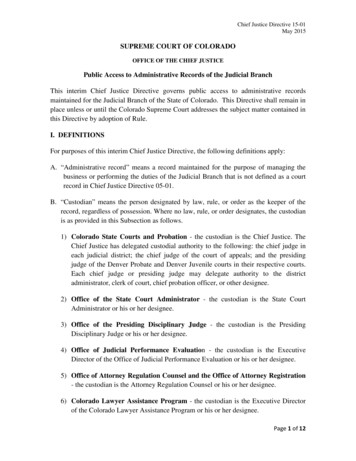
![IN THE SUPREME COURT OF T]-lE STATE OF MONTANA](/img/7/526b198c923f8.jpg)
